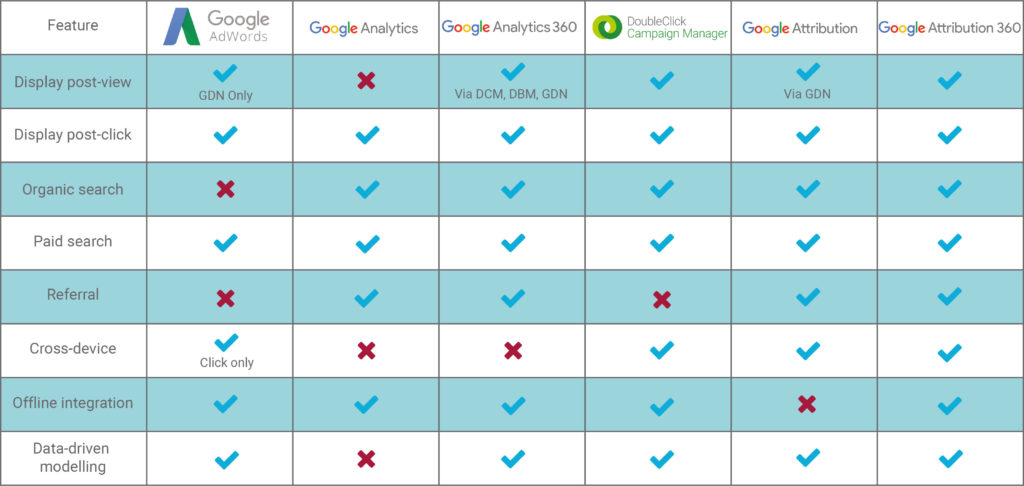This year promises to be the time when attribution comes of age and enters the mainstream of digital marketing. In this post, we look at what is changing to allow this to happen, and what you can be doing to prepare to take advantage of the new tools and technology becoming available.
What is attribution and why is it so important?
In order to determine where best to invest your marketing budget, you need to know which channels are driving the most relevant (converting) traffic to your site – but with so many channels and complex customer journeys, this can be almost impossible.
I’m sure many of you will have seen reports, such as the one below – a Channel Grouping report from Google Analytics, showing the routes taken by customers prior to converting on a website.

Historically, this report would have been relatively simple, perhaps including organic and paid search as the main channels. However, over time, customer ‘journeys’ to conversion have become more complex, usually involving several visits to your site prior to purchase. Aside from clicks on paid ads and organic search results, customers could have seen or clicked on programmatic display ads, interacted with paid or organic posts on social media channels or responded to an email marketing campaign. To further complicate the issue, all of the above could be split across different devices.
This is where attribution comes in. Google defines it as a way to “assign credit for sales and conversions to touchpoints in conversion paths”.
By accurately assigning credit to each touchpoint, you can identify which channels are contributing to your overall revenue, and then take action to adjust your marketing spend accordingly.
Why now?
Previously, attribution has been done on a very simplistic level, using a range of basic models in Analytics.
For example the default model, last non-direct click, only acknowledges the last touch-point prior to a conversion.

Additionally, attribution reports in tools such as AdWords or Facebook will give credit to that platform if it has had any involvement in the conversion, regardless of whether other channels have also played a part.
It is only recently that there have been a number of tools and technologies emerging that are able to solve the attribution problem.
Platforms such as DoubleClick Campaign Manager, Google Attribution and Google Analytics 360 allow integration of data from various sources into your attribution model that prevent double-counting of conversions and ensure credit is given to the relevant channel. All of these tools now include some form of the data-driven attribution model. Rather than being a fixed ‘last-click’/’first-click’ type algorithm, these models look at all the customer journeys in your data and analyze them to identify the contribution each channel has made to the overall conversions and revenue on your site.
While data-driven attribution has been available in the past, it has generally been a premium offering. It is only now finding its way into more and more tools, some of which are free or relatively low-cost.
What are the options?
Looking in more detail at the options for attribution, here is a brief summary of the tools you can look at in order to start working on attribution.

How to get started
Identify an attribution tool
Review your requirements and select the best available tool for building your attribution model.
This will be the tool that contains (or can contain) the most data about the traffic and conversions on your website. This will be across as many channels as possible, and if you are using display or social advertising, it will ideally include view-through as well as click-through conversions.
Think about other channels you may want to attribute to. It’s not possible to capture data from every interaction your customer has with your brand during the conversion process, but technology and processes can be optimized to capture as much of this information as possible.
As well as every visit and conversion on your site, data you should aim to capture includes:
- Email – have customers received email marketing? Did they open the email, or click on the links?
- Programmatic and social – have they viewed (but not clicked) your ads?
- Offline events – can you track which customers received catalogues or mail-shots?
- Offline orders – have any purchases been made via telephone or mail order? If so, see below for including offline conversions
- Refunds/returns – if clients return goods, can you take this into account?
Sort out your tagging, and define your channels
Once you’ve selected your tool, make sure all your data is being recorded accurately. Audit your analytics account and ensure all visits are being recorded accurately with the correct source/medium and campaign information.
You can then define channels to represent the level of granularity you want to attribute at – for example, you may well want to split paid search into brand and non-brand, by creating separate channels for specific campaigns. The more granular the channels, the more accurate your attribution will be, but it’s also important to make sure the output of the attribution model is actionable – so consider how you are going to use the data once your model is in place, and make sure the channels you create are options you can modify in your marketing budget.
Sort out offline conversions
In order for the attribution model to work, it will need accurate conversion data. Ideally for website conversions this will be fed into your tool directly from the check-out pages, but if your customers ultimately (or optionally) purchase off-line, you will need to integrate this off-line conversion data.
There are several ways to achieve this – Google provides an integration between Salesforce and Analytics 360 (check out our video explaining how this works) or for non-Salesforce users, you can use measurement protocol or data upload to import ‘hits’ into Analytics from your external CRM system.
For sites where you log in, you can also consider using the User ID to join on-line and off-line activity (albeit being mindful of the impact of GDPR on this level of tracking).
Get started
Affordable, accurate attribution tools are finally becoming a reality. As the number of marketing channels grows and customer journeys become ever more complex, these tools can decipher what is going on across your channels and give you insights that will allow you to make the most of your marketing budget.
For more information, please get in touch to speak to one of our experts.



